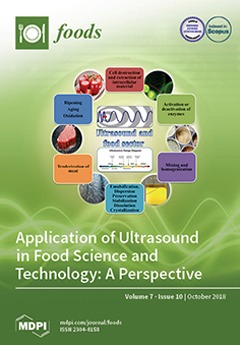Recently, there has been an increasing interest in integrating pulse flours into pastries and baked products to improve their nutritional and health benefits. “
Mankoushe,” a popular Lebanese pastry made up of refined wheat flour was enriched with chickpea flour that is
[...] Read more.
Recently, there has been an increasing interest in integrating pulse flours into pastries and baked products to improve their nutritional and health benefits. “
Mankoushe,” a popular Lebanese pastry made up of refined wheat flour was enriched with chickpea flour that is of better nutritional value, and its postprandial glycemia, insulinemia, lipidemia and appetite measures were monitored. A randomized cross-over study was performed on sixteen healthy Lebanese females, age (years): 22.90 ± 3.00, and BMI (kg/m
2): 22.70 ± 2.65. Over-night fasted females were asked to consume two iso-energetic meals (201 g; 681 kcal) on two separate days, three days apart. One meal was the “
Regular Mankoushe” (RM) made with white flour 100%, and the second meal was the “
Chickpeas Mankoushe” (CM) made with a mixture of wheat/chickpea flour (70/30). Blood samples were collected 15 min before meal ingest and at 30, 90, 150 and 210 min postprandial. Glucose, insulin, triglycerides (TG), ghrelin, and glucagon-like peptide 1 (GLP-1) plasma levels were measured. Subjective appetite rating and food intake were also assessed. Incorporation of pre-processed chickpea flour into “
Mankoushe” as 30% of the dough was associated with a modest reduction in both glucose and insulin levels, and TG was minimally affected. At the level of appetite hormones, changes in GLP-1 were similar, whereas the reduction in ghrelin was significantly lower after the RM meal and thus favored a higher satiating effect compared to CM. This was not paralleled by a similar change in subjective appetite scores and subsequent energy intake. In conclusion, findings suggest that pre-processed chickpea flour could be a promising functional ingredient of traditional pastries to improve their nutritional quality. Nevertheless, further investigations are warranted regarding its satiating effect.
Full article






